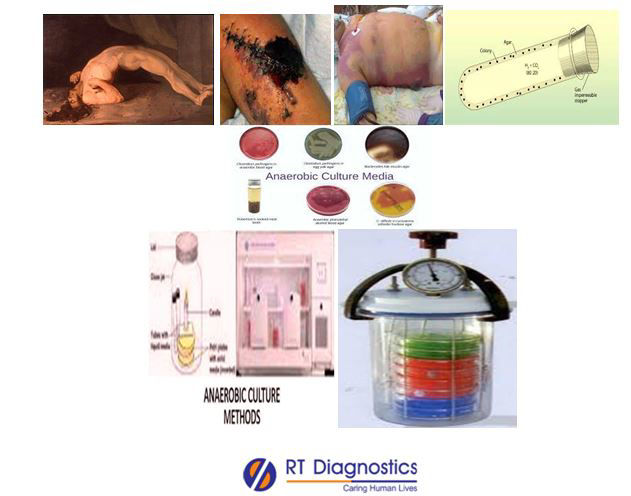Culture & Sensitivity: OT-Swab (Anaerobic):
Why Culture and Sensitivity – OT (anaerobic) Swab Test?
CLINICAL INFORMATION
Infections in an operation theatre (OT) can be acquired from many different sources such as the air, surface of various articles in the OT.Anaerobic microbes do not live or grow when oxygen is present. Examples of Gram positive anaerobes include Actinomyces, Clostridia species, Peptostreptococcus, Finegoldia, Cutibacterium etc. Gram negative anaerobes include Bacteroides, Fusobacterium, Prevotella, Porphyromonas etc. In human beings these are mostly found in gastrointestinal tract and genitourinary system. They play a vital role in pathologies related to appendicitis, diverticulitis, abscess, perforation of bowel etc. Their symptoms include grayish discoloration with hemorrhage, gas (gas-gangrene) in pus or infected tissues with foul odor, necrotic infected tissues etc. Most of these anaerobic infections are caused within the body, hence do not manifest physically during a clinical inspection. For example an infection caused by Clostridium tetani that gets inoculated by unclean puncture wound and survives within tissues, in its favorable anaerobic environment as the wound site gets sealed from outside environment. Thus physician performs clinical examinations in case of suspicion (such as, during palpation – crepitations can be felt in case of a gas gangrene) that may give leading clues of signs and symptoms for further investigations (lab tests such as glutamate dehydrogenase test and cytotoxic test for C. difficile antigen, Toxin test – Enzyme Immunoassay, NAAT (nucleic acid amplification test) test, in cases of diarrhea – ELISA tests for Salmonella, Shigella, Campylobacter, E coli etc). Hence as an additional supporting evidence, apart from site of surgery specimen may include blood (systemic infection), voided or catheterized urine, sample specimen from affected areas like throat, feces, rectal swab, pleural fluid, transtracheal aspirates, transthoracic pulmonary aspirates, bronchial wash etc. Other tests include abscess culture, body fluid culture, amplified nucleic acid detection etc. The operation theatre swab culture and sensitivity test is done to check and identify for anaerobic microbes on different equipments and surfaces in an operation theatre. The Culture and Sensitivity – OT Swab (anaerobic) test is performed as a surveillance procedure to determine if OT is free from harmful microbes and thus clean enough to use for any invasive therapeutic surgeries. Sensitivity (susceptibility) test results helps to assist the most effective medication and to rule out drug resistant strains (eg. MRSA etc). This test is of absolute importance because any surgical procedures require high level of sterility to be maintained (aseptic measures) in OT. For this purpose the surgical OT is always subjected to fumigation (performed in case of contamination of air) and strict protocols are followed before entering and during any surgical procedures. Complications of contaminated unclean equipments and surfaces can lead to nosocomial infections and iatrogenic infections (at the surgical sites). Thus it can have serious and long-standing effects on the post-surgical patients which can lead to extended hospital stay, increased resistance to anti-microbial medicines, long-term disability, additional financial burden on health care systems and rarely complications may also result in death of a patient. Some common infections that may rarely occur after in a few post-surgical cases include the infections caused by Clostridium species causing gas gangrene (causes Clostridial myonecrosis), tetanus ( caused by Clostridium tetani produces toxin called as tetanospasmin that spreads to the CNS, which blocks nerve signals from the spinal cord to the muscles causing severe muscle spasms) etc. General clinical signs and symptoms that may manifest in abnormal vitals like altered BP, respiratory rate, palpitation, pulse rate etc along with or without fever, cough, cold, emesis, loose stools, infection at the site of surgery, systemic infection, abscess, symptoms of UTI like conditions like pain and burning sensation while urinating, in infected post-operative female patients might present with redness and swelling around vagina, vaginal discharge etc. Specific manifestations includes trouble swallowing, lock jaw, risus sardonicus (spasm of the face muscles), opisthotonus (arching of spine), affects the respiratory muscles leading to breathing difficulties, causes irritability, urinary retention, loss of stool control etc. Therefore test result provides data on the type and count of the microbes in the OT and ascertains if there is any need for disinfection and/or any anti-septics. Other tests include blood tests, gram stain, PCR, stool culture or ova and parasite exam, glutamate dehydrogenase test and cytotoxic test for C. difficile antigen, Toxin test – Enzyme Immunoassay, NAAT (nucleic acid amplification test) test, in cases of diarrhea – ELISA tests for Salmonella, Shigella, Campylobacter, E coli etc, for presence of anaerobic pathogen.

General Instructions:
Sample Requirement: Specimen - Random OT Swab Specimen as guided by the physician. Test Preparation: None.
NOTE - Sample for specimen collections may vary based on the patient’s condition/cases according to the patient’s presenting complaints/signs or symptoms:
SPECIMEN REQUIREMENT (Special or Rare Cases) - As instructed and guided by Physician / Clinician / Pathologist / as per Laboratory’s requirements, according to procedures and protocols.
Sample Requirement: Random OT Swab Specimen as guided by the physician
Test Preparation: None
This Multi-Specialty Clinical Referral Laboratory RT DIAGNOSTICS provides precise and accurate tests with an extensive range of testing services to the medical centers to help in the diagnosis and identification of pathology in the test specimens for infectious diseases and also to evaluate the function of organ systems of the patient. It prevents further complications and helps to stabilize and restore health to near normalcy at the earliest without delay.



